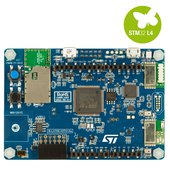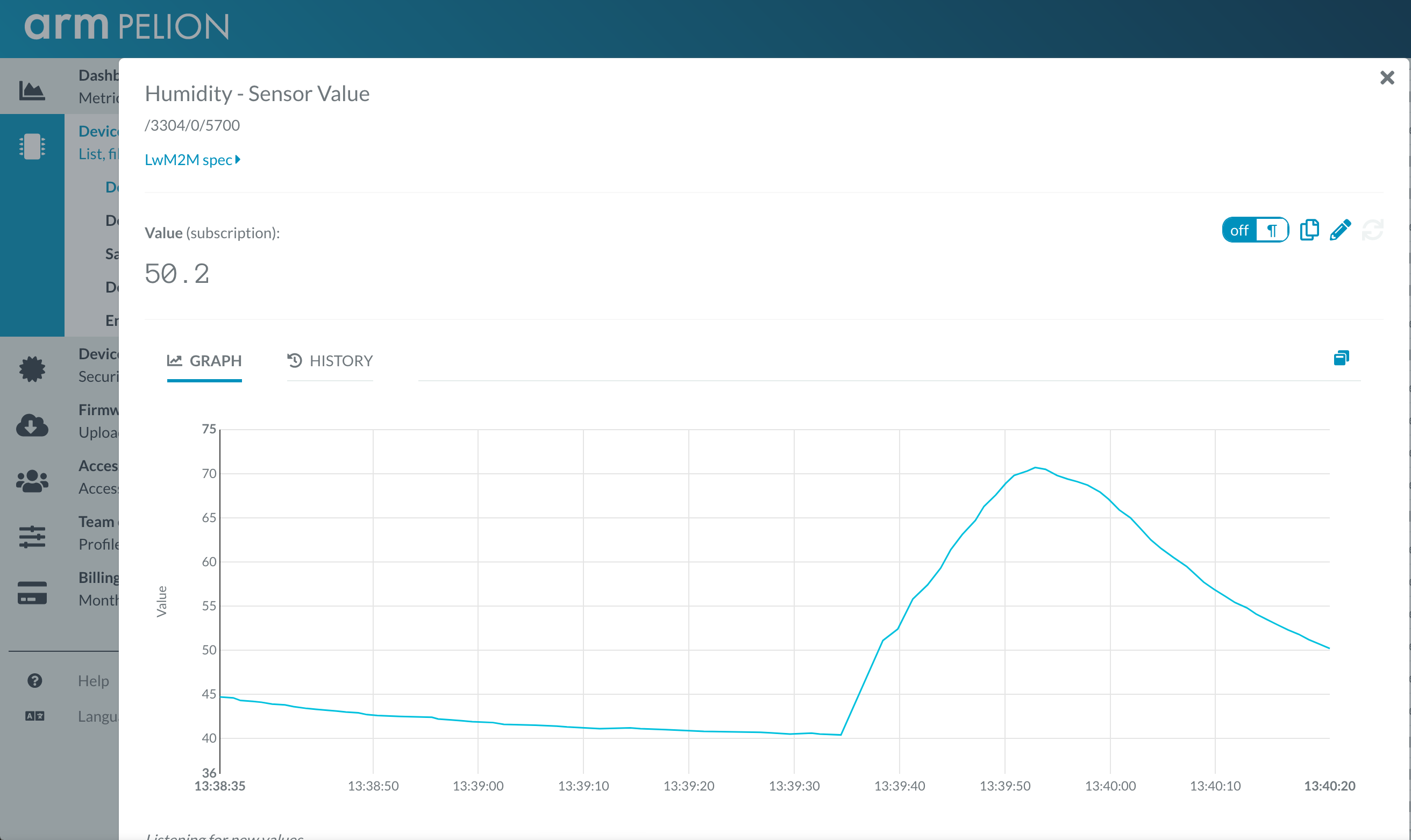Mbed OS and Pelion Device Management example over WIFI for DISCO_L475VG_IOT01 board
Dependencies: X_NUCLEO_COMMON ST_INTERFACES
DEPRECATED
This example application is not maintained and not recommended. It uses an old version of Mbed OS, Pelion DM and Arm toolchain. It doesn't work with Mbed Studio.
Please use: https://os.mbed.com/teams/mbed-os-examples/code/mbed-os-example-pelion/
This example is known to work on the following platforms:
- DISCO_L475E_IOT01A over WiFI and using onboard QSPI flash.

Follow the Quick-Start instructions: https://cloud.mbed.com/quick-start
Example functionality
This example showcases the following device functionality:
- Read onboard temperature and humidity sensors, and report them as Pelion LWM2M resources (see image below).
- On user button click, increment Pelion LWM2M button resource.
- Allow the user to change the state of the board LED from Pelion LWM2M led_state resource and PUT request.
- Uses all onboard sensors and reports them as Pelion LWM2M resources.

Use this example with Mbed CLI
1. Import the application into your desktop:
mbed import https://os.mbed.com/teams/ST/code/pelion-example-disco-iot01 cd pelion-example-disco-iot01
2. Install the CLOUD_SDK_API_KEY
mbed config -G CLOUD_SDK_API_KEY <PELION_DM_API_KEY>
For instructions on how to generate your API key, please see the documentation.
3. Initialize firmware credentials (done once per repository). You can use the following command:
mbed dm init -d "<your company name in Pelion DM>" --model-name "<product model identifier>" -q --force
If above command do not work for your Mbed CLI, please consider upgrading Mbed CLI to version 1.8.x or above.
4. Compile and program:
mbed compile -t <toolchain> -m DISCO_L475VG_IOT01A
(supported toolchains : GCC_ARM / ARM / IAR)
5. You can connect on a virtual terminal/COM port to the platform using:
mbed sterm -b 115200
This should give you an output similar to:
[BOOT] Mbed Bootloader [BOOT] ARM: 00000000000000000000 [BOOT] OEM: 00000000000000000000 [BOOT] Layout: 0 80096F4 [BOOT] Active firmware integrity check: [BOOT] SHA256: 0660E360D432225D5251461998FD8617B017098C5F1F90D5FB607BF8C27ED530 [BOOT] Version: 1553615309 [BOOT] Slot 0 is empty [BOOT] Active firmware up-to-date [BOOT] Application's start address: 0x8010400 [BOOT] Application's jump address: 0x8011041 [BOOT] Application's stack address: 0x20018000 [BOOT] Forwarding to application... Starting Simple Pelion Device Management Client example You can hold the user button during boot to format the storage and change the device identity. Sensors configuration: Invalid new address! HTS221 humidity & temperature = 0xBC LPS22HB pressure & temperature = 0xB1 LIS3MDL magnetometer = 0x3D LSM6DSL accelerometer & gyroscope = 0x6A Connecting to the network using Wifi... Connected to the network successfully. IP address: 192.168.1.3 Initializing Pelion Device Management Client... Initialized Pelion Client. Registering... Registered to Pelion Device Management. Endpoint Name: 0169********************001002d5 ADC temp: 23.0037 C, vref: 0.3661 V HTS221 temp: 28.700 C, humidity: 31.90 % LPS22HB temp: 29.600 C, pressure: 1032.01 mbar LIS3MDL mag: 0.217 x, -0.284 y, -0.053 z [gauss] LSM6DSL acc: 0.005 x, -0.014 y, 1.029 z [g] LSM6DSL gyro: 0.910 x, -0.910 y, 1.120 z [dps] VL53L0X dist: 1855 mm
Diff: main.cpp
- Revision:
- 10:b27c962b3c3f
- Parent:
- 9:265744785d33
- Child:
- 11:8df4529f060d
--- a/main.cpp Sun Oct 14 19:01:53 2018 +0100
+++ b/main.cpp Sat Dec 08 01:46:22 2018 +0000
@@ -18,7 +18,26 @@
#ifndef MBED_TEST_MODE
#include "mbed.h"
#include "simple-mbed-cloud-client.h"
-#include "FATFileSystem.h"
+#include "LittleFileSystem.h"
+
+//#define SENSORS_AND_BUTTONS
+#ifdef SENSORS_AND_BUTTONS
+#include "HTS221Sensor.h"
+#include "LPS22HBSensor.h"
+#include "LSM6DSLSensor.h"
+#include "lis3mdl_class.h"
+#include "VL53L0X.h"
+
+static DevI2C devI2c(PB_11,PB_10);
+static HTS221Sensor hum_temp(&devI2c);
+static LPS22HBSensor press_temp(&devI2c);
+static LSM6DSLSensor acc_gyro(&devI2c,LSM6DSL_ACC_GYRO_I2C_ADDRESS_LOW,PD_11); // low address
+static LIS3MDL magnetometer(&devI2c);
+static DigitalOut shutdown_pin(PC_6);
+static VL53L0X range(&devI2c, &shutdown_pin, PC_7);
+
+InterruptIn button(USER_BUTTON);
+#endif /* SENSORS_AND_BUTTONS */
// An event queue is a very useful structure to debounce information between contexts (e.g. ISR and normal threads)
// This is great because things such as network operations are illegal in ISR, so updating a resource in a button's fall() function is not allowed
@@ -29,19 +48,30 @@
// Default block device
BlockDevice* bd = BlockDevice::get_default_instance();
-FATFileSystem fs("sd", bd);
+SlicingBlockDevice sd(bd, 0, 2*1024*1024);
+LittleFileSystem fs("fs", &sd);
// Declaring pointers for access to Pelion Client resources outside of main()
MbedCloudClientResource *button_res;
MbedCloudClientResource *pattern_res;
-// This function gets triggered by the timer. It's easy to replace it by an InterruptIn and fall() mode on a real button
-void fake_button_press() {
- int v = button_res->get_value_int() + 1;
+#ifdef SENSORS_AND_BUTTONS
+// Additional resources for sensor readings
+MbedCloudClientResource *humidity_res;
+MbedCloudClientResource *temperature_res;
+MbedCloudClientResource *distance_res;
+#endif /* SENSORS_AND_BUTTONS */
- button_res->set_value(v);
+// When the device is registered, this variable will be used to access various useful information, like device ID etc.
+static const ConnectorClientEndpointInfo* endpointInfo;
- printf("Simulated button clicked %d times\n", v);
+/**
+ * Button function triggered by the physical button press or by timer depending on SENSORS_AND_BUTTONS macro.
+ */
+void button_press() {
+ int v = button_res->get_value_int() + 1;
+ button_res->set_value(v);
+ printf("Button clicked %d times\n", v);
}
/**
@@ -98,19 +128,134 @@
*/
void registered(const ConnectorClientEndpointInfo *endpoint) {
printf("Connected to Pelion Device Management. Endpoint Name: %s\n", endpoint->internal_endpoint_name.c_str());
+ endpointInfo = endpoint;
}
+#ifdef SENSORS_AND_BUTTONS
+/**
+ * Initialize sensors
+ */
+void sensors_init() {
+ uint8_t id;
+
+ // Initialize sensors
+ hum_temp.init(NULL);
+ press_temp.init(NULL);
+ acc_gyro.init(NULL);
+ magnetometer.init(NULL);
+ range.init_sensor(VL53L0X_DEFAULT_ADDRESS);
+
+ /// Call sensors enable routines
+ hum_temp.enable();
+ press_temp.enable();
+ //magnetometer.enable();
+ acc_gyro.enable_x();
+ acc_gyro.enable_g();
+
+ printf("\033[2J\033[20A");
+ printf ("\r\n--- Sensors configuration ---\r\n\r\n");
+
+ hum_temp.read_id(&id);
+ printf("HTS221 humidity & temperature = 0x%X\r\n", id);
+ press_temp.read_id(&id);
+ printf("LPS22HB pressure & temperature = 0x%X\r\n", id);
+ magnetometer.read_id(&id);
+ printf("LIS3MDL magnetometer = 0x%X\r\n", id);
+ acc_gyro.read_id(&id);
+ printf("LSM6DSL accelerometer & gyroscope = 0x%X\r\n", id);
+
+ printf("\n\r--- Reading sensor values ---\n\r"); ;
+}
+
+/**
+ * Update sensors and report their values.
+ * This function is called periodically.
+ */
+void sensors_update() {
+ float value1, value2;
+ int32_t axes[3];
+ uint32_t distance;
+
+ printf("\r\n");
+
+ value1 = value2 = 0.0;
+ hum_temp.get_temperature(&value1);
+ hum_temp.get_humidity(&value2);
+ if (endpointInfo) {
+ temperature_res->set_value(value1);
+ humidity_res->set_value(value2);
+ }
+ printf("HTS221: [temp] %.2f C, [hum] %.2f%%\r\n", value1, value2);
+
+ value1 = value2 = 0.0;
+ press_temp.get_temperature(&value1);
+ press_temp.get_pressure(&value2);
+ printf("LPS22HB: [temp] %.2f C, [press] %.2f mbar\r\n", value1, value2);
+ printf("Mag/Acc/Gyro readings: x, y, z\r\n");
+
+ magnetometer.get_m_axes(axes);
+ printf("LIS3MDL [mag/mgauss]: %6ld, %6ld, %6ld\r\n", axes[0], axes[1], axes[2]);
+ acc_gyro.get_x_axes(axes);
+ printf("LSM6DSL [acc/mg]: %6ld, %6ld, %6ld\r\n", axes[0], axes[1], axes[2]);
+ acc_gyro.get_g_axes(axes);
+ printf("LSM6DSL [gyro/mdps]: %6ld, %6ld, %6ld\r\n", axes[0], axes[1], axes[2]);
+
+ if (range.get_distance(&distance) == VL53L0X_ERROR_NONE) {
+ printf("VL53L0X [mm]: %6ld\r\n", distance);
+ if (endpointInfo) {
+ distance_res->set_value((int)distance);
+ }
+ } else {
+ printf("VL53L0X [mm]: --\r\n");
+ }
+
+ printf("\033[8A");
+}
+#endif /* SENSORS_AND_BUTTONS */
+
+
int main(void) {
printf("Starting Simple Pelion Device Management Client example\n");
printf("Connecting to the network using Wifi...\n");
+ // If the User button is pressed, then format storage.
+ const int PRESSED = 0;
+ DigitalIn *user_button = new DigitalIn(USER_BUTTON);
+ if (user_button->read() == PRESSED) {
+ printf("User button is pushed on start. Formatting the storage...\n");
+ int storage_status = fs.reformat(&sd);
+ if (storage_status != 0) {
+ if (sd.erase(0, sd.size()) == 0) {
+ if (fs.format(&sd) == 0) {
+ storage_status = 0;
+ printf("The storage reformatted successfully.\n");
+ }
+ }
+ }
+ if (storage_status != 0) {
+ printf("Failed to reformat the storage.\n");
+ }
+ }
+
+#ifdef SENSORS_AND_BUTTONS
+ sensors_init();
+#endif /* SENSORS_AND_BUTTONS */
+
// Connect to the internet (DHCP is expected to be on)
net = NetworkInterface::get_default_instance();
- nsapi_error_t status = net->connect();
+ nsapi_error_t net_status = -1;
+ for (int tries = 0; tries < 3; tries++) {
+ net_status = net->connect();
+ if (net_status == NSAPI_ERROR_OK) {
+ break;
+ } else {
+ printf("[WARN] Unable to connect to network. Retrying...\n");
+ }
+ }
- if (status != NSAPI_ERROR_OK) {
- printf("Connecting to the network failed %d!\n", status);
+ if (net_status != NSAPI_ERROR_OK) {
+ printf("Connecting to the network failed %d!\n", net_status);
return -1;
}
@@ -140,6 +285,24 @@
blink_res->methods(M2MMethod::POST);
blink_res->attach_post_callback(blink_callback);
+#ifdef SENSORS_AND_BUTTONS
+ // Sensor resources
+ temperature_res = client.create_resource("3303/0/5700", "temperature");
+ temperature_res->set_value(0);
+ temperature_res->methods(M2MMethod::GET);
+ temperature_res->observable(true);
+
+ humidity_res = client.create_resource("3304/0/5700", "humidity");
+ humidity_res->set_value(0);
+ humidity_res->methods(M2MMethod::GET);
+ humidity_res->observable(true);
+
+ distance_res = client.create_resource("3330/0/5700", "distance");
+ distance_res->set_value(0);
+ distance_res->methods(M2MMethod::GET);
+ distance_res->observable(true);
+#endif /* SENSORS_AND_BUTTONS */
+
printf("Initialized Pelion Client. Registering...\n");
// Callback that fires when registering is complete
@@ -150,8 +313,15 @@
// Placeholder for callback to update local resource when GET comes.
// The timer fires on an interrupt context, but debounces it to the eventqueue, so it's safe to do network operations
+#ifdef SENSORS_AND_BUTTONS
+ button.fall(eventQueue.event(button_press));
+
Ticker timer;
- timer.attach(eventQueue.event(&fake_button_press), 5.0);
+ timer.attach(eventQueue.event(sensors_update), 3.0);
+#else /* SENSORS_AND_BUTTONS */
+ Ticker timer;
+ timer.attach(eventQueue.event(&button_press), 5.0);
+#endif /* SENSORS_AND_BUTTONS */
// You can easily run the eventQueue in a separate thread if required
eventQueue.dispatch_forever();

